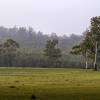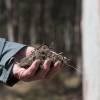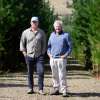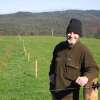
Lamb survivability, generations to benefit from trees on Evandale farm
Posted 20 October 2021
Managing trees On-farm benefits Economic benefits and markets Carbon benefits Tree Alliance
Trees have been integrated into this Evandale farm for the past 70 years, and the impacts shelterbelts are having on lamb survivability is noticeable.
About 70 years ago a businessman from Belgium decided to plant trees at his Evandale property in order to combat the prevailing north-westerly wind.
Clare Peltzer, who now manages the property, said her great grandfather had a great vision for the land.
“Great grandfather came out in the ‘50s from Belgium, and as a businessman decided to turn the place into a useable property by putting in rows of tree,” she said.
“I’m planting for my generation. Great grandfather did the same thing, luckily he was forward thinking.”

Clare, whose property Logan is one of PFT’s farm forestry demonstration sites, told the Forestry Australia field trip attendees that the paddocks with trees are noticeably warmer.
“The trees have been strategically placed for protection for the benefits of the sheep, and also for the fodder that we grow as well.
“For irrigation and pivots you do planning, trees were another one of those where you sit down and try and work out where the most beneficial place to put the trees will be knowing they will be here for the next 25 to 30 years,” she said.
Trees within the landscape are important for the primary industries sector.
At Logan the established shelterbelts improve lamb survivability. Logan has observed a minimum of a 7 per cent increase in lamb percentages in the paddocks that contain established shelterbelts.
On Logan, they lamb during August to try and capture the excess spring feed available which is also the wettest month of the year. This is when the shelter and microclimate, which is created by the trees, is best seen.

Logan farms prime lamb and, while the property has commercial trees selectively integrated, Clare says she is yet to call herself a tree farmer.
“The commercial value of the trees will be something to consider when the tree gets to size. It’s really tricky, we produce lamb and people say ‘well you produce trees as well’, and I say ‘yes, but I don’t know that market, I don’t know what to do’. So, hence, we will be looking into bringing professionals into the team as consultants to help us with that process.
“It would be lovely to take, say there are seven rows there, take out five rows and leave two behind, and then look at trying to keep the shelter while keeping the wood values. But at the moment for us they do such a good job that I can’t imagine the landscape without them.
“There are so many benefits of the shelter, and because lamb price and animal welfare standards are so high … as farmers you have to look after your livestock.”
Private Forests Tasmania’s Agriforester Molly Daskey-Willis said working with neighbours was a good strategy when it came to planting as well as harvesting shelterbelts.
“There are advantages to working with your neighbours. It can be more economical to bring in harvesting equipment so that costs can be split with neighbours, but also when deciding where to plant, trees could benefit your neighbour’s and vice versa.”

Share this Article
Latest Articles
-

04 November 2025
Prioritising outcomes for Tasmania's private forest growers in 2024-25
-

20 October 2025
Tasmanian High Soil Carbon Landscapes project
-

17 September 2025
Celebrating excellence at the Tasmanian Timber Awards
Archives
- ActivAcre hits milestone, calls for more farmers to get on board
- Napier's leading the way in sustainable forestry and carbon-neutral farming
- Sound science needed to assess carbon impacts of timber harvesting
- Newly appointed TFFPN Board of Directors
- Graduate Certificate of Forestry Scholarship
- Forestry Australia Mentoring Program 2025
- Forest Industry Roundtable planning for the long term
- Eagle Management Constraint Period extended
- Successful private native forest management celebrated
- $15 million investment in new ship loader to boost Bell Bay's forestry exports
- Standing with Tasmania's forestry industry: buy local
- TFPA: Tasmanian Freight Equalisation Scheme needs a ground-up review
- AFCA Gala Dinner celebrates industry excellence
- Fire permits now required Statewide
- Forest leaders hone skills in sustainable native regrowth management
- Tasmanian forests and the carbon market: Barriers and opportunities
- What the 2024-25 Tasmanian Budget means for forestry
- Spring is the time for fuel reduction burning
- Primed for Growth: A situation analysis of the Tasmanian Forest and Wood Products Sector
- Audit requirements cut for low-risk plantation projects
- Guidance and support for landowners after damaging winds
- Forestry Australia welcomes further definition of active forest management
- Farm & Forest Mapper Tool highlighted at Rural Youth Tasmania's Young Farmer of the Year competition
- Senate Select Committee inquiry into the Tasmanian Freight Equalisation Scheme
- Timberlink announces new wood composite products brand
- Newly developed protocol a vital tool for safeguarding forestry industry
- Red Hot Tips: Fire management for Tassie farmers
- Bioenergy: Fuelling industries with trees
- Harvesting trees: What you need to know
- Shelterbelts: How are they contributing to farm systems?
- Infill plantings and remnant vegetation: Why biodiversity depends on a thriving understory
- Plantation planning: The key to a successful plantation
- Exciting interactive forestry knowledge hub launched
- $450,000 farm forestry grant recipients revealed


